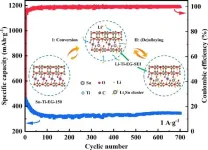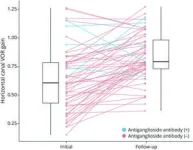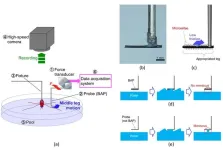Battery capacity is one of the primary bottlenecks in efficient renewable energy storage and significant reductions in carbon emissions. As a battery anode that releases electrons in a lithium-ion battery (LIB), tin (Sn) and Sn-mixture alloys could theoretically store more energy at a higher density than more common carbon-based anodes. Pairing a Sn-Ti bimetal element with inexpensive ethylene glycol (Sn-Ti-EG) mitigated many of the challenges of using Sn as an anode material and produced an inexpensive LIB with excellent storage and performance characteristics.
Sn and Sn alloys, or mixture of another metal with Sn, could outperform other anode materials but suffer from poor stability due to the expansion of the metal during charging and discharging. One way to overcome this limitation is by creating a metal-organic framework (MOF) that maintains rapid electron transfer (energy flow) while providing good stability during charging and recharging. Materials scientists recently created a Sn-Ti-EG bimetal organic compound MOF that demonstrated high electricity conduction, energy capacity and stability through many charging and discharging cycles.
The researchers published their study in the journal Energy Materials and Devices on November 20.
“Significant efforts have been directed toward developing high-capacity cathode and anode materials for high energy-density LIBs. Because the capacities of well-known cathode materials, for example LiFePO4, Ni-rich layered oxides and LiMn2O4, have reached their theoretical limits, more attention is being focused on finding anode materials that have high energy densities as a substitute for the commonly used graphite anodes that have a relatively low theoretical capacity and tap density.” said Zhen-Dong Huang, senior author of the study and professor in the State Key Laboratory for Organic Electronics and Information Displays & Jiangsu Key Laboratory for Biosensors at Nanjing University of Posts and Telecommunications in Nanjing, China.
Specifically, anodes made from graphite, a crystalline form of carbon, have a theoretical capacity of 372 mAh g-1, which refers to the amount of electric charge (milliampere hours or mAh) the material can deliver per gram (g-1) of that material. In contrast, Sn, bismuth (Bi) and antimony (Sb) metals have higher theoretical capacities than graphite anodes. Sn anodes, for example, have a theoretical capacity of 994 mAh g-1, but suffer from stability issues due to expansion.
“To resolve the stability issues associated with Sn anodes, a myriad of strategies have been explored, including minimizing the particle size, introducing inert metals and assembling with carbon materials. Moreover, rationally designed structures, such as hollow, layered and
core–shell structures play an important role in alleviating volume expansion. Although these strategies helped the cyclic stability to a certain degree, the… energy densities of the nanostructured Sn-based anodes are normally low. In contrast, metal–organic frameworks have an intrinsically porous structure that not only provides a large number of active sites but also enables rapid electrolyte penetration and electron/ion transfer,” said Huang.
The research team created a unique MOF made up of Sn, Ti and EG that leveraged beneficial characteristics of each component to create a more stable anode material with high electrochemical performance. EG, for example, served as an organic bridge between positively charged Sn2+ and Ti4+ ions to complete the battery circuit. Ti additionally contributed to the improved structure and stability of the material. Sn contributed its higher theoretical capacity, improving the anode material’s electrochemical performance.
Ultimately, the team created a new, inexpensive LIB anode material that maintained a high specific capacity of 345 mAh g-1 at a current density of 1000 mA g−1 after 700 cycles, which demonstrates the stability of anode material. Scanning electron microscope pictures confirmed that the anode material had no cracks after 700 cycles.
Further analysis of the Sn-Ti-EG anode material revealed that the strong interaction between the Sn and carbon-oxygen species was responsible for the high specific capacity and excellent cyclic stability of the electrode, which may help future researchers design additional anode materials with similar characteristics. The research team sees this latest advance in anode specific capacity as a stepping stone to additional LIB materials that can improve battery storage capacity and be produced efficiently at large scale.
Other contributors include Yuqing Cai, Haoran Li, Qianzi Sun, Xiang Wang and Ziquan Li from the State Key Laboratory for Organic Electronics and Information Displays & Jiangsu Key Laboratory for Biosensors at the Institute of Advanced Materials in the Jiangsu National Synergetic Innovation Center for Advanced Materials at the Nanjing University of Posts and Telecommunications in Nanjing, China; Haigang Liu from the Shanghai Synchrotron Radiation Facility in the Shanghai Advanced Research Institute at the Chinese Academy of Sciences in Shanghai, China; and Jang-Kyo Kim from the Department of Mechanical Engineering at Khalifa University in Abu Dhabi, United Arab Emirates.
This research was supported by the National Natural Science Foundation of China (52277219, 61974072, 52032005), the Project of State Key Laboratory of Organic Electronics and Informa- tion Displays, Nanjing University of Posts and Telecommunications (GZR2022010024), Postgraduate Research & Practice Innovation Program of Jiangsu Province (KYCX22_0992), Khalifa University financial support (FSU 2023-022, PD#8295), and the Shanghai Synchrotron Radiation Facility (BL07U).
About Energy Materials and Devices
Energy Materials and Devices is launched by Tsinghua University, published quarterly by Tsinghua University Press, aiming at being an international, single-blind peer-reviewed, open-access and interdisciplinary journal in the cutting-edge field of energy materials and devices. It focuses on the innovation research of the whole chain of basic research, technological innovation, achievement transformation and industrialization in the field of energy materials and devices, and publishes original, leading and forward-looking research results, including but not limited to the materials design, synthesis, integration, assembly and characterization of devices for energy storage and conversion etc.
About SciOpen
SciOpen is a professional open access resource for discovery of scientific and technical content published by the Tsinghua University Press and its publishing partners, providing the scholarly publishing community with innovative technology and market-leading capabilities. SciOpen provides end-to-end services across manuscript submission, peer review, content hosting, analytics, and identity management and expert advice to ensure each journal’s development by offering a range of options across all functions as Journal Layout, Production Services, Editorial Services, Marketing and Promotions, Online Functionality, etc. By digitalizing the publishing process, SciOpen widens the reach, deepens the impact, and accelerates the exchange of ideas.
END






